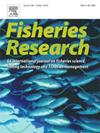中缘鱿鱼的生活史特征、成熟和能量分配
IF 2.2
2区 农林科学
Q2 FISHERIES
引用次数: 0
摘要
Enoploteuthid鱿鱼数量丰富,是商业渔业中典型的副渔获物,在中上层边界群落的营养结构中起着重要作用。本文通过对台湾海峡东南海域多哈布利亚(abalia multihamata)的statolith显微结构分析,对其生活史特征和成熟进行了研究。此外,还评估了体细胞和生殖生长之间的能量分配与成熟期和孵化季节的关系。结果表明,299只孵化后个体的估计年龄在43 ~ 150天之间,全年都有孵化,秋季为孵化高峰。在成熟、生长模式和能量策略方面观察到显著的两性二态性。雄性比雌性(36.0 ~ 37.6 mm, 50.3 ~ 70.3天)的体长(25.8 ~ 28.2 mm)要小,但成熟期(68.4 ~ 78.8天)要大。雌性和雄性的非渐近和渐近生长模型分别最好地用指数和von Bertalanffy生长函数来描述,尽管仍需要预先招募个体来建立完整的生长模式。在不同的孵化季节,雄性的躯体状况、终生生长和生殖投入存在显著差异,而雌性的这些指标则随着生殖发育而变化。这表明,在相对能量需求不同的情况下,雌雄多花田鼠可能采用了性别特异性的能量利用策略。躯体状态和生殖投资之间没有能量权衡,但终生生长和生殖投资之间存在负相关,这支持了头足类动物优先从摄入的食物中获取能量来维持躯体和生殖状态的假设。本文章由计算机程序翻译,如有差异,请以英文原文为准。
Life-history traits, maturation, and energy allocation of a small mesopelagic squid Abralia multihamata
Enoploteuthid squids are abundant and are typically bycatch in commercial fisheries, playing a significant role in the trophic structure of the mesopelagic boundary community. The life-history traits and maturation of Abralia multihamata in the waters off the southeastern Taiwan Strait were studied through statolith microstructure analysis. Additionally, energy allocation between somatic and reproductive growth was evaluated in relation to maturity stage and hatching season. The results indicated that the estimated age of 299 post-recruit individuals ranged from 43 to 150 days and that hatching occurs year-round, with a peak in autumn. Significant sexual dimorphism was observed in maturation, growth patterns, and energy strategies. Males began maturing at a smaller size (25.8–28.2 mm) but at an older age (68.4–78.8 days) than females (36.0–37.6 mm at 50.3–70.3 days). Non-asymptotic and asymptotic growth models were best described by the exponential and von Bertalanffy growth function for females and males, respectively, though pre-recruit individuals are still needed to establish complete growth patterns. Significant differences in somatic condition, lifetime growth, and reproductive investment were observed in males across hatching seasons, whereas these measures in females varied with reproductive development. This suggests that A. multihamata females and males, with differing relative energetic demands, likely employ sex-specific energy utilization strategies. There were no energy trade-offs between somatic condition and reproductive investment but negative correlations between lifetime growth and reproductive investment, supporting the hypothesis that cephalopods prioritize energy from ingested food to maintain both somatic and reproductive conditions.
求助全文
通过发布文献求助,成功后即可免费获取论文全文。
去求助
来源期刊

Fisheries Research
农林科学-渔业
CiteScore
4.50
自引率
16.70%
发文量
294
审稿时长
15 weeks
期刊介绍:
This journal provides an international forum for the publication of papers in the areas of fisheries science, fishing technology, fisheries management and relevant socio-economics. The scope covers fisheries in salt, brackish and freshwater systems, and all aspects of associated ecology, environmental aspects of fisheries, and economics. Both theoretical and practical papers are acceptable, including laboratory and field experimental studies relevant to fisheries. Papers on the conservation of exploitable living resources are welcome. Review and Viewpoint articles are also published. As the specified areas inevitably impinge on and interrelate with each other, the approach of the journal is multidisciplinary, and authors are encouraged to emphasise the relevance of their own work to that of other disciplines. The journal is intended for fisheries scientists, biological oceanographers, gear technologists, economists, managers, administrators, policy makers and legislators.
 求助内容:
求助内容: 应助结果提醒方式:
应助结果提醒方式:


